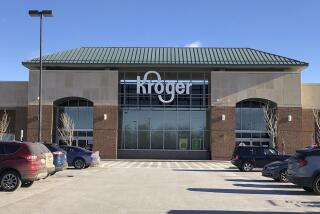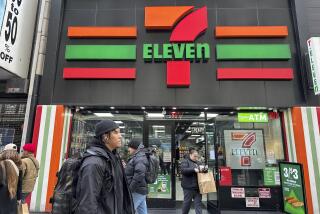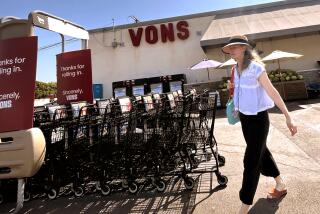7-Eleven Sprucing Up to Woo Women, Wall Street
- Share via
After a decade of being retailing’s ubiquitous doormat, 7-Eleven Inc. is finally showing signs that it can leverage its enormous size and familiar brand name to generate solid growth.
7-Eleven is maneuvering on several fronts to make its stores more inviting, appeal more to female shoppers, broaden its product line and swell its profit to garner renewed support on Wall Street, which had largely turned its back on the battered, debt-ridden company and its stock.
The company is striving to be much more than a quick stop for consumers needing gasoline, a cold drink, a late-hour snack, a lottery ticket or a pack of smokes. Consider some of 7--Eleven’s most recent steps:
* The company named a new chief executive, James W. Keyes. As 7-Eleven’s chief operating officer, Keyes was credited with helping infuse 7-Eleven outlets with fresher foods such as daily-delivered deli items and baked goods, introduce a broader mix of merchandise, oversee the chain’s first wave of new store openings in years and power a sharp jump in its overall sales.
* It has been installing state-of-the-art electronic scanning systems to better monitor sales, control inventories and replenish fast-selling items more quickly. It’s also remodeling stores and upgrading their night lighting for safety.
* It’s testing in-store kiosks that provide free maps and automated-teller and check-cashing services. The kiosks also have Internet links that enable consumers to order items such as video games and music online and pick up items ordered online.
To help finance the moves and further cut its debt, 7-Eleven plans to sell up to 10 million additional common shares. 7-Eleven just completed a reverse 1-for-5 stock split, so that its stock would lose its paltry valuation--it had traded for under $4 a share--and hopefully gain more respect among investors. The stock closed Friday at $18.63 a share, up 25 cents for the day, on Nasdaq.
The Dallas-based company also plans to move its stock from the Nasdaq Market to the New York Stock Exchange next month and recently got another cash infusion from its biggest investors.
Put it all together and “we believe 7-Eleven is poised on the brink of strong, high-teens earnings growth based on new fresh-food products, the introduction of state-of-the-art in-store technology and new store openings,” said analyst Mark Husson of Merrill Lynch & Co.
It’s been a long time coming for 7-Eleven, which has 19,700 outlets worldwide, including about 5,700 in the United States and Canada that serve about 6 million customers daily. (About 60% of its North American stores are run by franchisees; the rest are company-owned.) The entire chain generated global sales last year of $27 billion.
The overhaul hasn’t been quick or easy. “It was like trying to change a tire while the car was rolling,” said Keyes, 45. But now, he said, “I have my food on the accelerator.”
What sparked the changes? For starters, 7-Eleven knew that its traditional inventory--convenience items such as beer and magazines--wasn’t a growth business and “was not much of a barrier to entry for your competition,” Keyes said. Indeed, many gasoline stations--notably the AM/PM outlets at BP Amoco’s Arco stations--offer many of the same items.
Still, 7-Eleven also knew that food and drinks comprise 60% of its sales, yet only 6% of those items were fresh. “It’s not that our customers don’t look for food and drinks at 7-Eleven stores, but what we couldn’t deliver on was the promise of freshness,” said Keyes, who was in the oil industry before joining 7-Eleven in 1992.
7-Eleven already had a huge distribution system in place to deliver its stores’ merchandise, so Keyes and others started re-configuring that system and its suppliers to get fresh food--such as deli items, baked goods and salads--into its stores every day.
7-Eleven’s research also shows the fresher food especially appeals to women. The chain also is taking other steps to garner more female customers.
Case in point: 7-Eleven historically sold pantyhose like most other retailers, “in large packages,” Keyes said. Not very convenient. So 7-Eleven got a manufacturer to put a pair of pantyhose “in a package a little bigger than a lipstick container . . . that can fit in a pursue or briefcase,” he said.
Many of these changes haven’t reached Los Angeles yet, however. Most of the region’s 7-Elevens are run by franchisees, who first wanted proof that the initiatives were working. “We hope by the end of this year to have [the changes] well underway at most of the stores in L.A.,” Keyes said.
7-Eleven was started by the Thompson family in 1927 and steadily expanded over the next half-century. Its name was adopted in the mid-1940s, when its hours of operation were 7 a.m. to 11 p.m. Most stores now are open 24 hours a day.
But the company ran into serious trouble in 1987 when--facing a hostile takeover threat by the Belzberg family of Canada--it kept its independence by borrowing nearly $5 billion to take itself private in a management buyout.
The debt nearly buried 7-Eleven. The company (then known as Southland Corp.) was forced to file for reorganization under the bankruptcy laws in 1990 and was bailed out by two Japanese firms, Ito Yokado Co. and its majority-owned unit 7-Eleven Japan Co., one of 7-Eleven’s longtime licensees.
The two companies pumped $430 million into 7-Eleven in exchange for 70% of its ownership in 1991, but 7-Eleven continued to languish during the ‘90s as it still had to pay down a big chunk of high-interest bonds. “With a heavy load of debt, 7-Eleven went into high-yield hibernation for most of the ‘90s,” analyst Husson recalled.
The bonds are still burdensome. 7-Eleven’s long-term debt totaled $1.8 billion as of Dec. 31, leaving the company with a negative net worth--that is, the sum of its debts minus its assets--of $560 million.
But Keyes predicts that figure will turn positive by year’s end, because of 7-Eleven’s planned secondary stock offering and because, in March, Ito Yokado and 7-Eleven Japan invested another $540 million into 7-Eleven to bolster the company’s balance sheet and help pay for its new stores and e-commerce venture.
Those moves also prompted Moody’s Investors Service to upgrade its rating on 7-Eleven’s debt to investment-grade status which, among other things, makes 7-Eleven’s bonds available to many more pension-fund managers and other institutional investors that are restricted from buying securities rated below investment grade.
With those actions and the roll-out of its merchandising initiatives, 7-Eleven is starting to recover.
In this year’s first quarter, its profit more than doubled from a year earlier, to $14.8 million, though that still amounted to less than a penny for every dollar of revenue, which totaled $2.1 billion in the quarter.
Even so, 7-Eleven’s “same-store” sales of merchandise--those of stores open at least a year, and retailing’s primary gauge of success--jumped a stout 9% from a year earlier after gaining 9.8% for all of 1999. Only two years earlier, 7-Eleven’s same-stores sales had risen a meager 1.5%.
The new electronic-scanning system also is a big plus because it gives 7-Eleven a much better idea of its customers’ tastes. Such systems are old news for most retailers, but among convenience chains such as 7--Eleven, it’s a step forward.
“In the past, a store manager had no idea what the inventory was or what was selling,” Husson said.
7-Eleven also sells gasoline at about 41% of its stores in the U.S. and Canada, and those sales amounted to 28% of 7-Eleven’s overall revenue in the first quarter. The spike in gasoline prices in the first quarter also kept 7-Eleven’s profit from showing an even bigger gain.
But 7-Eleven’s biggest challenge might still lie ahead: Promoting the “new” 7-Eleven. Its huge size certainly means word of mouth will help. And once the company’s initiatives have been rolled out nationwide, the company plans to step up promotion with television and radio advertising, Keyes said.
The chain’s bid for a new image might best be illustrated by its plans to advertise its new female personal products in Glamour and other women’s magazines. It’s a step, Keyes noted, “that was once unheard of for 7-Eleven.”
(BEGIN TEXT OF INFOBOX / INFOGRAPHIC)
7-Eleven by the Numbers
After years of struggling under massive debt, 7-Eleven is finally rebounding with stronger sales, a broader range of merchandise and additional stores. Here are some facts about the giant convenience store chain:
*
Stores worldwide: 19,700*
Sales worldwide: $27 billion*
North American stores: 5,700*
Employees: 33,700
1999 revenue: $8.4 billion
1999 profit: $83.1 million
Headquarters: Dallas
Chief executive: James W. Keyes
*
Merchandise Sales
By category in North America:**
Cigarettes/tobacco: 25.8%
Beverages: 22.9%
Beer/wine: 10.8%
Candy/snacks : 9.4%
Other: 31.1%
*
**Excludes sales of gasoline at selected stores.
*Includes company-owned and franchised outlets
Source: Company reports
More to Read
Inside the business of entertainment
The Wide Shot brings you news, analysis and insights on everything from streaming wars to production — and what it all means for the future.
You may occasionally receive promotional content from the Los Angeles Times.











